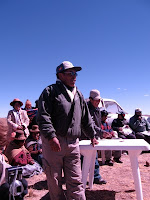 OK, so what exactly is a vicuna?
OK, so what exactly is a vicuna? A vicuna is a camelid, e.g. a me
mber of the biological family camelidae. Vicunas along with alpacas and llamas, are descended from guanacos, (all are camelidae). All live in the mountainous regions of South America, in this case, in the Andes. Vicunas have short coats of extremely fine fiber which are only harvested every 2 or 3 years. Communities in the Andes such as Picotani are responsible for their flocks, which is challenging as vicuna do not live in domestication. Vicuna are kept in vast fenced in areas where they can live freely, but occasionally be rounded up for shearing and other purposes, like entertaining foreign visitors such as myself.
So, after a chilly first night at the guest house in Mallkini--the wood stove didn't really suffice to heat the rooms, in the morning I discovered that there was no window which had an inside wooden shutter; the second night they had put the window back in and it was warmer!--we boarded the bus and drove 2 hours or so to Picotani for the vicuna chaco, or roundup. Picotani is in the province of Puno as is Mallkini; Puno is just north and west of Lake Titicaca. This map shows the location of Puno in green.
View Larger Map
View Larger Map

Here is the welcome sign to the community. They had a guest book with names of folks from all over, although this place felt incredibly remote. After arriving, we drove up through the fenced in area to an area where there was a ceremony thanking Pachamama, the earth mother, for her gifts. This ceremony involved the burning of coca leaves and sipping and pouring several types of liquor on the ground. There was at this point not a vicuna in sight.

The whole (Quechua speaking) community was there, including women and children, often clothed in handknits of Red Heart worsted, although the adorable little guy in this photo looks like he was wearing a hand knit alpaca. Coulda sold the photo to National Geograhic if my camera had been on the correct setting!

After the ceremony, in which we travellers particiated by selecting coca leaves and dipping adding them to glass of

liquor, and after the remainders of the bottles of liquor were consumed by the men, came the chaco, or roundup. In this process, the whole community of amazing walkers formed a long line, forming a human fence, led by a lucky man who owned a moped. They then walked for about an hour, combing the outside of the property, to round up the vicunas. In the photo you can see the line of walkers at the top of the hill, and the vicunas being led to the opening to the corral.


No comments:
Post a Comment